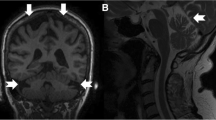Abstract
This study aimed to determine if cerebellar ataxia, hypogonadism and chorioretinopathy (AHCR) is associated with mutations in mitochondrial DNA or in genes responsible for spinocerebellar ataxias (SCA1, SCA2, SCA3 and Friedreich’s ataxia). Two brothers with cerebellar ataxia, hypogonadism and chorioretinopathy and their unaffected parents underwent molecular analysis for duplications and deletions in mitochondrial DNA (mtDNA), point mutations in the ATP ase 6 gene, and expansions of CAG repeats (at 6p22-p23, 12q24.1, 14q32.1) and of GAA repeats (at gene X25 on chromosome 9q13). The research was negative for all mutations. Our findings confirm that AHCR is a distinct disease within the inherited cerebellar ataxias.
Sommario
La sindromc di atassia cerebellare, ipogonadismo e corioretinopatia (AHCR) è itna varierà rara di atassia cerebellare, i cui rapporti nosografici con le altre atassie cerebellari ereditarie (SCA1, SCA2, SCA3, atassia di Friedreich (FA), etc.) sono sconosciuti. In due fratelli affetti da AHCR e nei low genitori abbiamo effettuato un’analisi molecolare per mutazioni SCA1, SCA2, SCA3 e FA, e per mutazioni del DNA mitocondriale (NARP e delezioni-duplicazioni), L’assenza delle mutazioni indagate dimostra che la sindrome AHCR è nosograficamente distinta dalle atassie cerebellari ereditarie, già definite da un punto di vista molecolare.
Similar content being viewed by others
References
Rosenberg RN (1995) The genetic basis of ataxia. Clin Neurosci 3:1–4
Kawaguchi Y, Okamoto T, Taniwaki M et al (1994) CAG expansions in a novel gene for Machado-Joseph disease at chromosome 14q32.1. Nat Genet 8:221–228
Orr Ht, Chung M, Banfi S et al (1993) Expansion of an unstable trinucleotide CAG repeat in spinocerebellar ataxia type 1. Nat Genet 4:221–226
Campuzano V, Montermini L, Moltò MD et al (1996) Friedreich’s ataxia: Autosomal recessive disease caused by an intronic GAA triplet repeat expansion. Science 271:1423–1427
Pulst SM, Nechiporuk A, Nechiporuk T et al (1996) Moderate expansion of a normally biallelic trinucleotide repeat in spinocerebellar ataxia type 2. Nat Genet 14:269–276
Benomar A, Le Guern E, Dürr A et al (1994) Autosomaldominant cerebellar ataxia with retinal degeneration (ADCA Type II) is genetically different from ADCA type I. Ann Neurol 35:439–444
Benomar A, Krols L, Stevanin G et al (1995) The gene for autosomal dominant cerebellar ataxia with pigmentary macular dystrophy maps to chromosome 3p12-p21.1. Nat Genet 10:84–888
Holt IJ, Harding AE, Petty RK, Morgan HJA (1990) A new mitochondrial disease associated with mitochondrial DNA heteroplasmy. Am J Hum Genet 46:428–433
Baroncini A, Franco N, Forabosco A (1991) A new family with chorioretinal dystrophy, spinocerebellar ataxia and hypogonadotropic hypogonadism (Boucher-Neuhauser syndrome). Clin Genet 39:274–277
Boucher BJ, Gibberd FB (1969) Familial ataxia, hypogonadism and retinal degeneration. Acta Neurol Scand 45:507–510
Erdem E, Kiratli H, Erbas T et al (1994) Cerebellar ataxia associated with hypogonadotropic hypogonadism and chorioretinopathy: A poorly recognized association. Clin Neurol Neurosurg 96:86–91
Fok ACK, Wong MC, Cheah JS (1989) Syndrome of cerebellar ataxia and hypogonadotropic hypogonadism: Evidence for pituitary gonadotropin deficiency. J Neurol Neurosurg Psychiatry 52:407–409
Franceschetti A, Klein D (1948) Hérédo-ataxies par dégénérescence spino-ponto-cérébelleuse: III-les manifestations tapéto-rétiniennes et leur importance clinique et génétique. Rev Oto-Neuro-Ophthalmol 20:109–166
Limber ER, Bresnick GH, Lebovitz RM, Appen RE, Gilbert-Barness EF, Pauli R (1989) Spinocerebellar ataxia, hypogonadotropic hypogonadism, and choroidal dystrophy (Boucher-Neuhauser syndrome). Am J Med Genet 33:409–414
Casademont J, Barrientos A, Genis D, Estivill X, Urbano-Marquez A, Nunes V (1996) 5.5-kb heteroplasmic mitochondrial DNA deletion in a patient with ataxia, hypogonadism, and choroid dystrophy. Neurology 46:A198–199
Filla A, De Michele G, Cavalcanti F et al (1996) The relationship between trinucleotide (GAA) repeat length and clinical features in Friedreich ataxia. Am J Hum Genet 59:554–560
Author information
Authors and Affiliations
Rights and permissions
About this article
Cite this article
Rizzi, R., Carelli, V., Monari, L. et al. Cerebellar ataxia, hypogonadism and chorioretinopathy: molecular analysis of an Italian family. Ital J Neuro Sci 19, 41–44 (1998). https://doi.org/10.1007/BF03028811
Received:
Accepted:
Issue Date:
DOI: https://doi.org/10.1007/BF03028811




